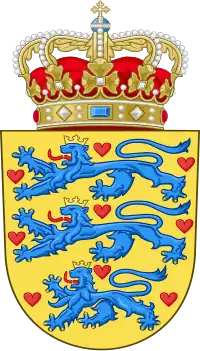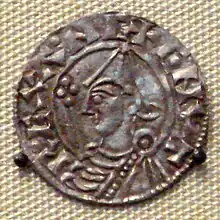Welcome to the Denmark Portal! | ||||
 |
 |
 | |
Denmark is the smallest and southernmost of the Nordic countries. Unified in the 10th century, it is also the oldest. Located north of its only land neighbour, Germany, south-west of Sweden, and south of Norway, it is located in northern Europe. From a cultural point of view, Denmark belongs to the family of Scandinavian countries although it is not located on the Scandinavian Peninsula. The national capital is Copenhagen.
Denmark borders both the Baltic and the North Sea. The country consists of a large peninsula, Jutland, which borders Schleswig-Holstein; many islands, most notably Zealand, Funen, Vendsyssel-Thy, Lolland, and Bornholm; and hundreds of minor islands often referred to as the Danish Archipelago. Denmark has historically controlled the approach to the Baltic Sea, and those waters are also known as the Danish straits.
Denmark has been a constitutional monarchy since 1849 and is a parliamentary democracy. It became a member of the European Economic Community (now the European Union) in 1973. The Kingdom of Denmark also encompasses two off-shore territories, Greenland and the Faroe Islands, both of which enjoy wide-ranging home rule. The Danish monarchy is the oldest existing monarchy in Europe, and the national flag is the oldest state flag in continuous use.
Selected biography

Canute the Great (d. November 12, 1035) was a Danish king of England, Denmark, Norway, and Sigtuna in Sweden, as well as overlord of Pomerania, and the Mark of Schleswig. He, in treaty with the Holy Roman Emperors, Henry II and Conrad II, as well as, in good relations with the papacy, was the ruler of a Scandinavian domain which saw the Kingdom of Denmark at its height. Though after the death of his heirs within a decade of his own and the Norman conquest of England in 1066, his legacy was largely lost to history, historian Norman F. Cantor has made the paradoxical statement that he was "the most effective king in Anglo-Saxon history".
Cnut was of Danish and Slavic descent. His father was Sweyn Forkbeard, King of Denmark (which gave Cnut the patronym Sweynsson, Old Norse Sveinsson). Cnut's mother was the daughter of the first duke of the Polans, Mieszko I; her name may have been Świętosława, but the Oxford DNB article on Cnut states that her name is unknown.
As a prince of Denmark, Cnut won the throne of England in 1016 in the wake of centuries of Viking activity in northwestern Europe. His accession to the Danish throne in 1018 brought the crowns of England and Denmark together. Cnut held this power-base together by uniting Danes and Englishmen under cultural bonds of wealth and custom, rather than sheer brutality. After a decade of conflict with opponents in Scandinavia, Cnut claimed the crown of Norway in Trondheim in 1028. The Swedish city Sigtuna was held by Cnut. He had coins struck which called him king there, but there is no narrative record of his occupation.
Recently selected: Jacob Riis - Bertel Thorvaldsen - Rasmus Rask
Selected picture

Photo credit: User:EPO
Selected article

Antoine de la Calmette was a Hugenot whose family had been forced to leave France for Holland. His father was a diplomat who after terms in Switzerland and Portugal, finally arrived in Denmark where, in 1776, the family was naturalised and recognised as Danish nobility.
In January 1777, he married Catharina Elisabeth Iselin, the daughter of the Swiss baron Reinhard Iselin who had also emigrated to Denmark. In 1783, Antoine was appointed prefect of Møn. The same year, he bought six hectares of land on the eastern coast of the island in the parish of Magleby.
He and his wife, who travelled widely, had become interested in Jean-Jacques Rousseau's philosophy of naturalism in the Age of Enlightenment. As a result, Antoine designed the park in the Romantic spirit of the time as a loving gift for his wife. It was intended as a retreat where the family could spend a few days or weeks at a time, often with invited guests, away from the hardships of their working lives at Marienborg on the other side of the island.
Selected place

The ring castle had an inner diameter of 240 metres. The ditch was located eight meters outside the rampart, and was approximately 1.3 metres deep. The wall is believed to have been four metres tall. The rampart was constructed of soil and turf, reinforced and clad with oak wood. The rampart formed the basis for a wooden parapet. Smaller streets were located within the four main sections of the fortress.
Categories
Denmark topics
Things you can do
![]() TASKS
TASKS
- Expand stubs:
Geography stubs · People stubs · Denmark stubs in general
Help us extend these stubs and make them real articles!
- Categorize:
Help us categorize Denmark-related articles
- WikiProjects:
Have a look at WikiProject Denmark, WikiProject Faroe Islands, WikiProject Greenland and WikiProject Norse history and culture
- Noticeboard:
Have a look at the Danish Wikipedians' notice board
- Geotag:
Find coordinates for these locations and tag them: articles missing geocoordinate data
Related portals
Northern Europe
Other countries
Associated WikiMedia
The following Wikimedia Foundation sister projects provide more on this subject:
-
 Commons
Commons
Free media repository -
 Wikibooks
Wikibooks
Free textbooks and manuals -
 Wikidata
Wikidata
Free knowledge base -
 Wikinews
Wikinews
Free-content news -
 Wikiquote
Wikiquote
Collection of quotations -
 Wikisource
Wikisource
Free-content library -
 Wikispecies
Wikispecies
Directory of species -
 Wikiversity
Wikiversity
Free learning tools -
 Wikivoyage
Wikivoyage
Free travel guide -
 Wiktionary
Wiktionary
Dictionary and thesaurus